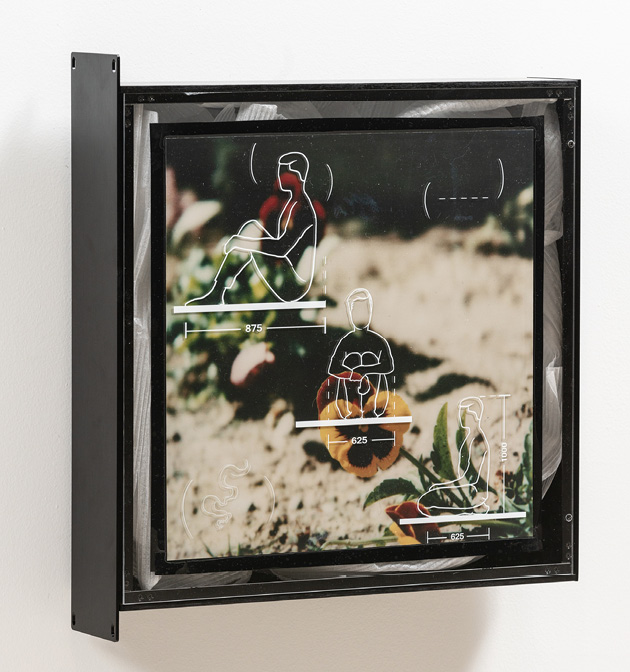Cécile B. Evans’ stand alone installation, “Something Tactical is Coming,” generates a deliciously satisfying SciFi dystopian theatricality. The bulk of the installation at Chateau Shatto is comprised of a production set from the second episode of her three-part video series “Amos’ World.” Effectively divided into two spaces, the installation delivers the fictitious architectural office interior of Amos, the character for whom the series is named. On the obverse side of the structure, a frame of wood studs and unfinished hardboard, the episode is story-boarded with a loosely schematic narrative scrawled in Sharpie and a lattice of small video screens (without audio) broadcasting rushes; that is, extra scene footage not used in the final cut.
Evans’ projects typically explore the darker side of human systems and infrastructure, in which she extrapolates ideas to their logical ends—with a healthy dose of ironic wit. Here, and in “Amos’ World,” she takes on the Utopian aspirations of Modernist architecture. Amos could be modeled after any number of Modern architects articulating a grand vision for idealized urban life. The most prominent example would be Le Corbusier, the designer behind the L’unite D’habitation in Marseille—a building of modular housing units adhering to Le Corbusier’s notions of aesthetics, communal living and harmonious existence with nature.
Even without the complete video of episode 2, the installation, its title derived from a foreboding line in the story, takes on an absorbingly world-building aspect, echoing SciFi literature and film, and conversely, failed idealism. The loosely sketched narrative with its B-movie campiness and darkly Orwellian overtones offers the satisfaction of fright-film goose bumps and the familiar ring of a ghost story.

Cécile B. Evans, Forgiveness Isn’t Always The Best Thing To Ask For (Character Study), 2019, courtesy of the artist and Château Shatto, Los Angeles, photograph by Elon Schoenholz.
Affixed to the gallery walls, two illustrations of human figures, which look as if they have been taken from an architectural standards book from the 1950s, indicate guidelines for designing to human scale. These drawings are attached to empty server housings—the computer infrastructure that digitizes, stores and serves up the virtual analog of human thoughts, memories and experience.
The artist asserts that the systems humans develop tend to shape humanity in turn, a theme that can also be evidenced in the installation’s video fragments, the rushes from “Amos’ World,” where puppeteers dressed in Chroma key blue manipulate Amos—Evans’ archetypal designer, personified as a puppet
The argument could be made that the reconstructed set from “Amos’ World” demystifies the video and dilutes its world-building, turning the project into an engineering problem and making precious the artifacts of the art-making process, to the detriment of the art itself. There is some merit to this view, yet Evans doesn’t appear to be interested in world-building so much as unraveling the logic of world-building—whether applied to a model of Utopian architectural as seen here, or as in many of her other projects, which comment on the alienating effects of technology. Her work is trenchant commentary, albeit with lots of cheek.


